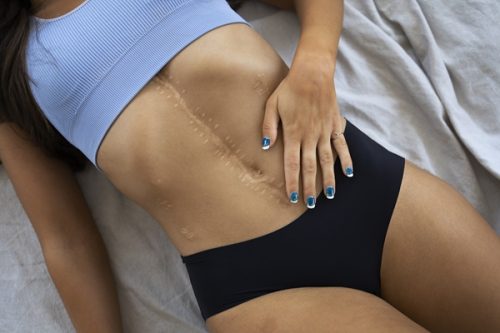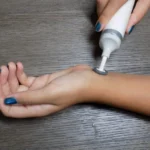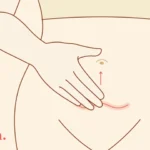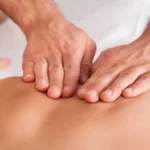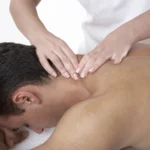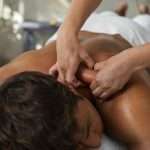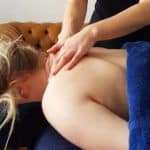Want to reduce the appearance of a scar? Whether it’s from surgery, injury, or acne, massaging a scar can be a simple yet effective way to improve healing. Scar massage helps break down excess tissue, boost circulation, and relieve tightness or discomfort. In this article, we’ll walk you through easy, step-by-step techniques you can use at home to gently massage your scar and support your skin’s natural recovery process.
Table of Contents
What is Scar Massage?

Scar massage is a therapeutic technique designed to help reduce the appearance of scars from surgery, injuries, or medical conditions. By applying gentle pressure to the scar tissue, this method helps soften and break down dense tissue, easing discomfort and encouraging smoother skin. In addition to improving the scar’s appearance, regular massage can restore flexibility and improve the movement of nearby muscles and tendons—helping the affected area function more comfortably and naturally.
🤱 Recovering from a C-section?
Explore our full guide on C-section scar massage techniques to learn how gentle, targeted massage can support healing, reduce tightness, and help you reconnect with your postpartum body.
When to Start Scar Massage
The right time to begin scar massage depends on how your wound is healing. In general, you should wait until:
- The wound is fully closed — no open areas, scabs, or oozing
- There is no more bleeding or risk of infection
- Your doctor or healthcare provider gives you the go-ahead
For most people, this is typically 2 to 4 weeks after surgery or injury, but it can vary. Starting too early can disrupt healing, so always check with your healthcare provider before beginning any massage routine. Once it’s safe to begin, gentle, consistent massage can make a big difference in how your scar looks and feels over time.
Why Massage Scars?

Massaging a scar can help reduce its appearance and improve its texture. It can also improve blood circulation, reduce redness, and decrease pain and discomfort. Massaging a scar can also help break down scar tissue, making it softer and more flexible.
Massaging a scar can also help to reduce the appearance of a scar over time. By massaging a scar, you can help to reduce the appearance of its size and shape, making it less noticeable.
Massaging a scar can also help to reduce the appearance of hyperpigmentation, which is when a scar is darker than the surrounding skin. Hyperpigmentation can occur due to the body’s natural healing process, but by massaging a scar, you can help to reduce it.
Finally, massaging a scar on the face can help to reduce the appearance of fine lines and wrinkles. As the scar tissue is softened and the skin is stimulated, the appearance of wrinkles can be reduced.
When to Start Massaging a Scar?

The most important thing to consider before starting to massage a scar is to wait until all the stitches or staples are removed and the wound is healed. If the wound is still healing or the scar has not fully formed, massaging the area could cause more harm than good. So it is recommended to wait until the scar is completely healed and the stitches or staples are removed before attempting to massage it.
Generally speaking, it is best to wait at least 6 weeks before starting to massage a scar. This gives the scar enough time to heal and form properly. However, it is best to consult with a doctor or a licensed physical therapist to get the most accurate information about the best time to start massaging a scar.
For surgical scars, it is important to ask the doctor when to start massaging the scar. Usually, the doctor will give specific instructions about how to massage scars after surgery. It is important to follow these instructions to ensure that the scar heals properly and the massage does not cause any further damage.
How to Massage a Scar?

Massaging a scar can help reduce its appearance and improve the skin’s flexibility. Scar massage is a simple technique that can be done at home and requires no special tools or equipment. Here’s what you need to know about scar massage:
What is Scar Massage?
Scar massage is a type of physical therapy used to improve the texture and appearance of a scar. The massage helps to break down scar tissue and improve the mobility of the skin surrounding the scar.
How to Massage a Scar:
- Wash your hands and the scar area with soap and warm water.
- Apply a light layer of oil, such as olive oil, to the scar.
- Gently massage the scar using your fingertips in a circular motion.
- Be sure to massage in a slow, gentle manner. Do not apply too much pressure.
- Massage the scar for 5 minutes, 2-3 times per day.
- After massaging, apply a moisturizer to the scar.
Scar massage is a safe and effective way to reduce the appearance of a scar and improve the skin’s flexibility. It is important to be gentle with your skin and not to apply too much pressure. If you experience any pain or discomfort during the massage, stop and seek medical advice.
How to Massage Scar Tissue on Face?
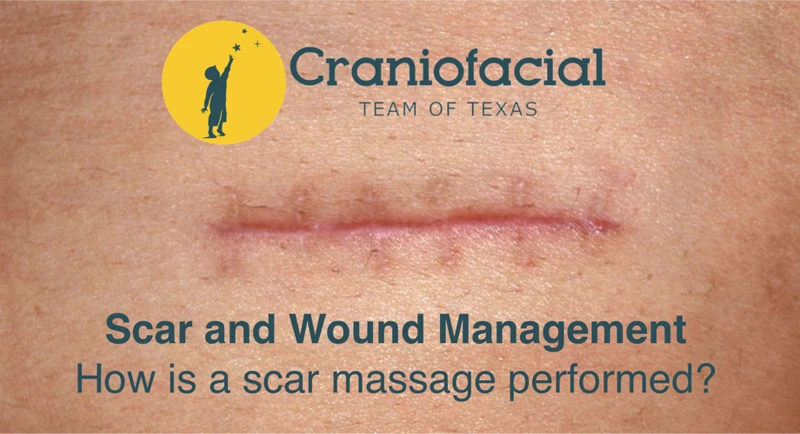
For massaging facial scars, it is important to use gentle, circular motions. This can help to break down scar tissue, and improve circulation and blood flow to the area. Start by applying a generous amount of oil or moisturizer to the skin. This will help to protect your skin from any potential irritation.
To massage a scar on the face, you will need to use gentle, circular motions. Start by cleaning the skin with warm water and a mild cleanser. Pat the skin dry and apply a light moisturizer.
Using your fingertips:
| Step | Instructions |
|---|---|
| 1 | Gently press your fingertips into the scar tissue. Start in the center, and then move outwards in small circles. |
| 2 | Continue to massage in a circular motion, moving outwards from the center. |
| 3 | Repeat this process for a couple of minutes. |
| 4 | When finished, wipe off any excess oil/moisturizer with a damp cloth. |
Using your knuckles:
| Step | Instructions |
|---|---|
| 1 | Place the tips of your knuckles on the scar tissue. Move them in small circles. |
| 2 | Continue to massage in a circular motion, moving outwards from the center. |
| 3 | Repeat this process for a couple of minutes. |
| 4 | When finished, wipe off any excess oil/moisturizer with a damp cloth. |
Massaging scar tissue can help to reduce the appearance of keloid scars, as well as improve the texture and elasticity of the skin. However, it is important to note that this method may not work for everyone. If you have any concerns, it is important to consult your doctor.
How to Massage Scars After Surgery?

- Wait for the wound to heal: After surgery, wait for the wound to heal completely before massaging it. This can take up to 6 weeks.
- Clean the wound area: Before massaging the scar, use mild soaps and warm water to clean the area. Make sure to rinse the area thoroughly.
- Use a moisturizer: Apply a moisturizer to the scar before massaging it to help prevent skin irritation. This can help reduce inflammation as well as moisturize the skin.
- Massage the scar: Use light, circular motions to massage the scar. This can help break up the scar tissue and reduce its appearance. Avoid massaging the wound area too vigorously, as this can cause pain and inflammation.
- Repeat the process: Repeat the massage process every day to help reduce the appearance of the scar. The more often you massage the scar, the more beneficial it will be.
Massaging scars after surgery can help reduce their appearance and restore a more natural look to the skin. Massaging helps to break up scar tissue, which can help reduce the appearance of the scar. Additionally, massaging can help improve circulation to the area, which can help reduce inflammation and help the skin heal more quickly.
How to Massage Keloid Scars?
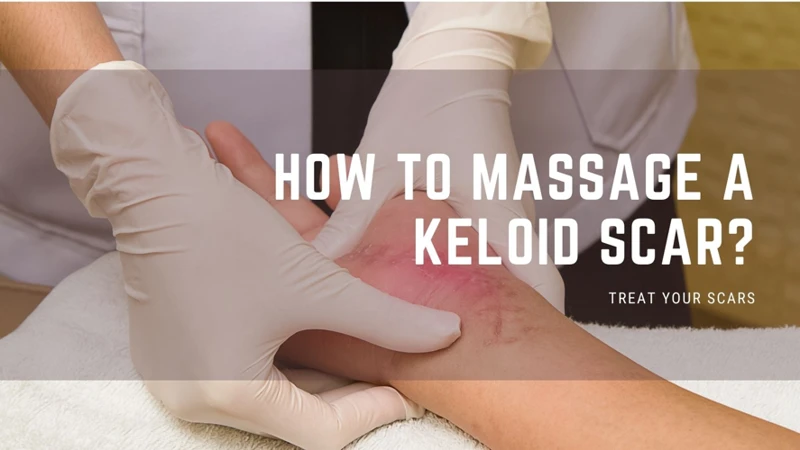
Keloid scars are raised, reddish-purple scars that form when the body produces too much collagen after an injury. Massage can help reduce the appearance of these scars by improving the circulation of blood and lymphatic fluid in the surrounding tissue, as well as breaking down fibrous scar tissue.
- Prepare the area: Gently clean the area surrounding the scar with warm water and a mild soap. Pat dry with a soft towel.
- Apply oil or cream: Apply a small amount of a natural massage oil or cream to your fingertips and rub into the scar.
- Gently massage: Massage the scar in small, circular motions. Take care not to press too hard, as this can cause discomfort. Continue the massage for 5-10 minutes.
- Treat the lip tissue: How to massage lip scar tissue? Gently pinch the lip scar tissue between your thumb and forefinger. Gently roll the lip scar tissue between your fingers for a few seconds, then release. Repeat for 5-10 minutes.
- Finish the massage: When finished, rinse the area with warm water and pat dry with a soft towel. Apply a natural moisturizer, such as coconut oil, to help keep the area hydrated.
Massaging a keloid scar can help reduce its appearance and improve its texture over time. It is important to remember to be gentle and not to press too hard when massaging the scar, as this can cause discomfort. Regular massage can help reduce the appearance of a keloid scar, and provide a more comfortable experience.
How to Massage Lip Scar Tissue?
Scar massage is a simple, natural technique that helps reduce scarring. It is a gentle massage that helps to break down scar tissue and promote healing. When it comes to lip scars, it is important to be gentle and not pull or stretch the skin.
Steps for Massaging Lip Scar Tissue:
| Step | Description |
|---|---|
| 1 | Clean the area with mild soap and warm water. |
| 2 | Apply a light moisturizer to the area. |
| 3 | Gently massage the area in a circular motion with your fingertips. Do not pull or stretch the skin. |
| 4 | Continue massaging for a few minutes. |
| 5 | Wash your hands and apply a light moisturizer again. |
For best results, massage your lip scar tissue every day. Doing this regularly will help to reduce the appearance of the scar and improve the skin’s elasticity. If you have any questions or concerns about massaging your lip scar tissue, consult your healthcare provider.
Frequently Asked Questions
What types of massage techniques are best for scar tissue?
Scar tissue massage techniques are best done using gentle, slow, circular motions. This helps to break down the collagen fibers in the scar tissue, reduce tension in the area, and improve circulation. Deep tissue massage techniques, such as kneading, may be too harsh and can lead to further injury or discomfort. It is important to use a light pressure and be mindful of the patient’s comfort level. Massage tools, such as a soft foam roller, can also be used to help break down scar tissue.
How often should I massage a scar?
Massaging a scar should be done at least three times a week, for about 15 minutes each session. However, it should be done more often if the scar is still red and raised. Massaging can be done daily until the scar flattens and blends in more with the surrounding skin.
Are there any potential risks associated with massaging a scar?
Massaging a scar can be beneficial, but it is important to be mindful of any potential risks. If the scar is fresh, it is best to wait until it has healed before attempting to massage it. Massaging a fresh wound can open it up and cause further damage. Additionally, if the scar is particularly tender, massaging it may be painful and could cause further irritation. In cases of infection, massage should not be attempted as it can worsen the infection and further complicate the healing process.
Is massage suitable for all types of scars?
Massage can be beneficial for most types of scars, but not all. Massage should not be performed on:
- Deep or wide scars, such as those caused by a burn, surgery, or injury.
- Scars that are less than 6 months old or are still healing.
- Scars that are very sensitive.
- Scars that are raised or have sharp edges.
- Scars that are causing pain.
It is important to be aware that some scar types may not respond to massage. However, massage can be beneficial for some types of scars, including stretch marks, hypertrophic, and keloid scars. Massage can help soften and flatten scar tissue and reduce its visibility. It can also help reduce pain and itching associated with scarring. Massage can also help improve blood circulation and stimulate the lymphatic system, which can help the body to naturally heal and reduce the appearance of scars.
Does Massage Help Reduce the Appearance of Scars?
Yes, massage can help reduce the appearance of scars. Massage can help to break down scar tissue, increase circulation, and promote healing. When combined with other treatments, massage can be an effective way to improve the appearance of scars. By improving circulation and breaking down scar tissue, massage can help to reduce raised, red, and discolored scars. Additionally, massage can help to improve the texture of scars, making them smoother and softer.
Conclusion
Massaging a scar is a simple, non-invasive way to support your skin’s healing process. By encouraging collagen production and improving circulation, regular massage can help soften scar tissue, reduce tightness, and improve skin texture over time. Whether used on its own or alongside other treatments, scar massage is a powerful tool to help fade the appearance of scars and restore confidence in your skin.
📚References
- Effects of Massage on Scar Tissue: A Systematic Review
- Scar Massage
- Massage: Get in touch with its many benefits
⚠️ Disclaimer:
This article is for informational purposes only and does not constitute medical advice. Always consult with a licensed healthcare provider or certified massage therapist before beginning any new treatment, especially if you have pre-existing health conditions or concerns.

